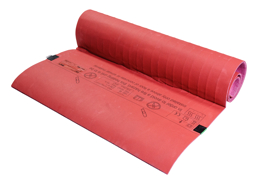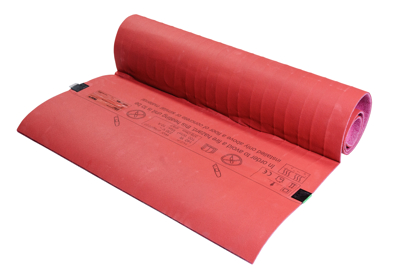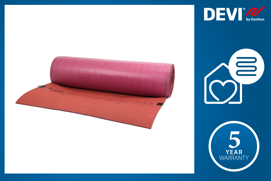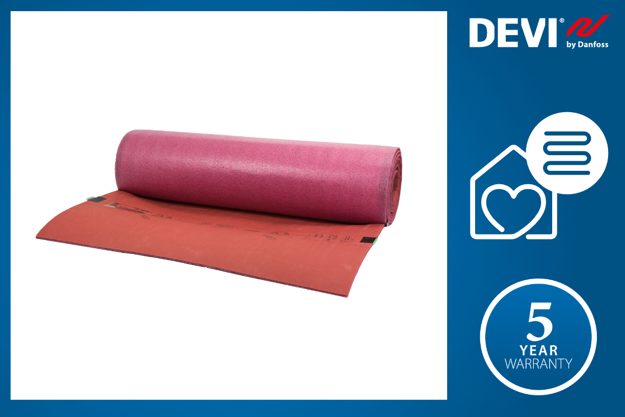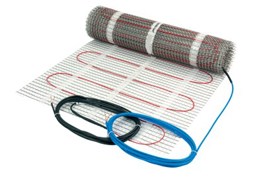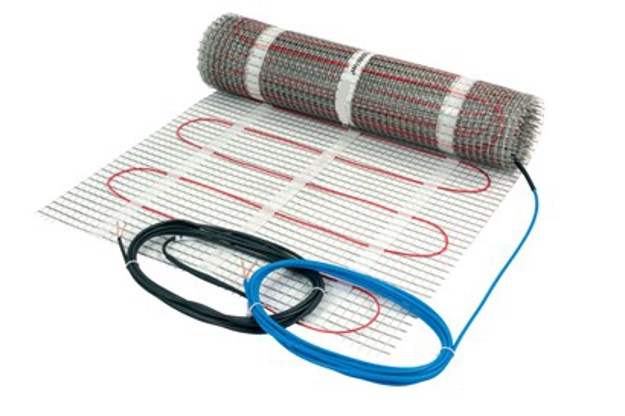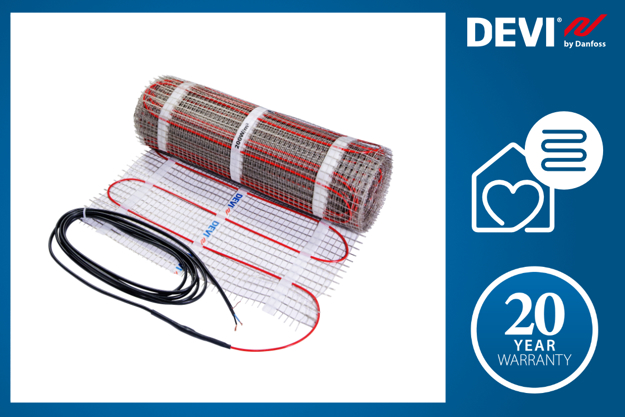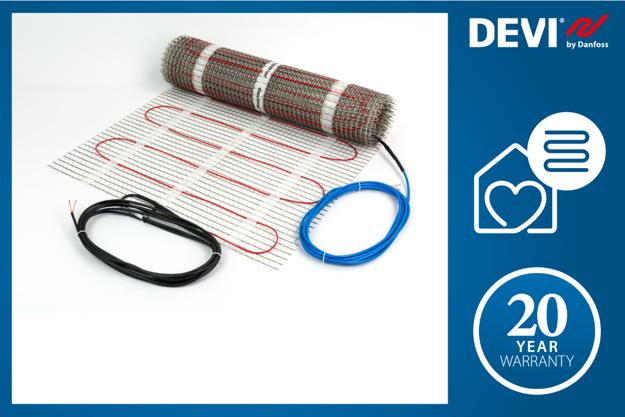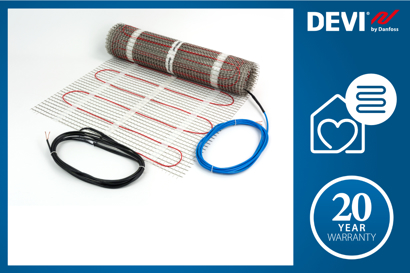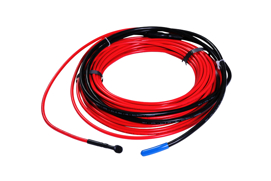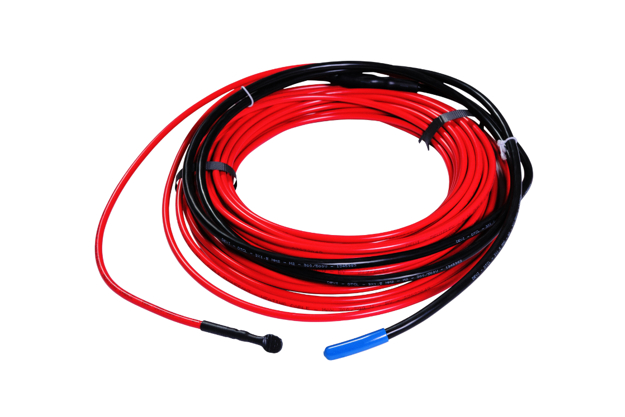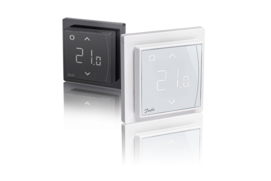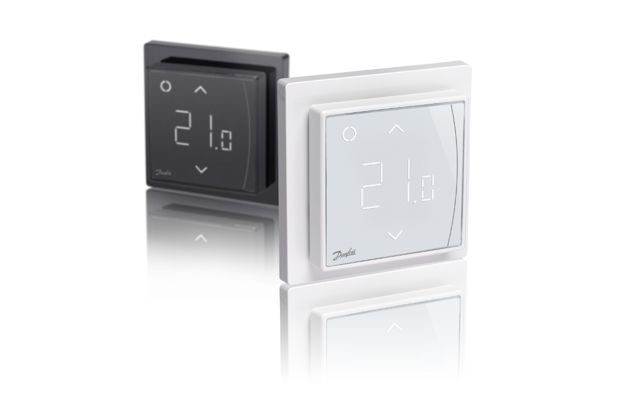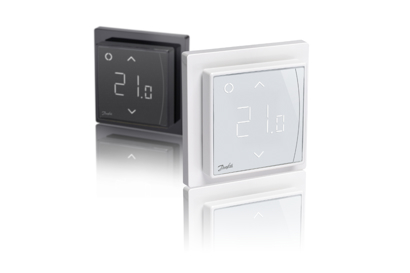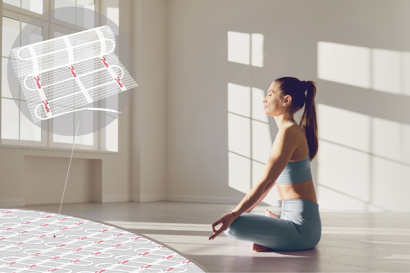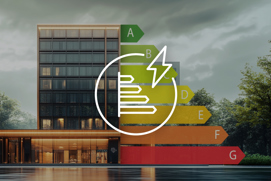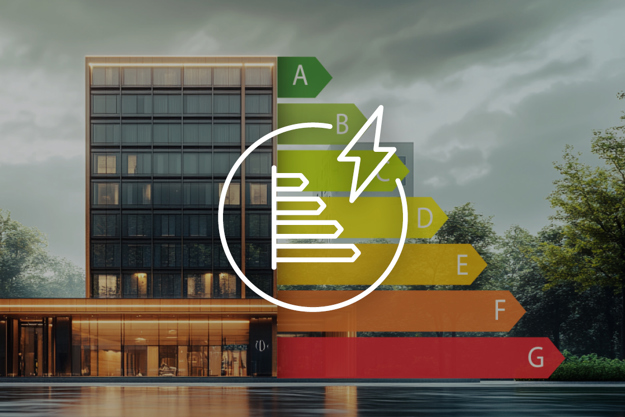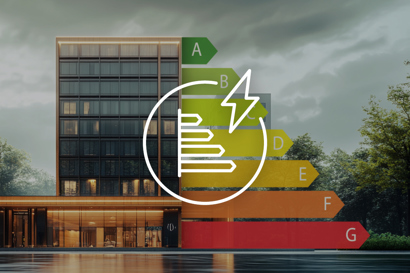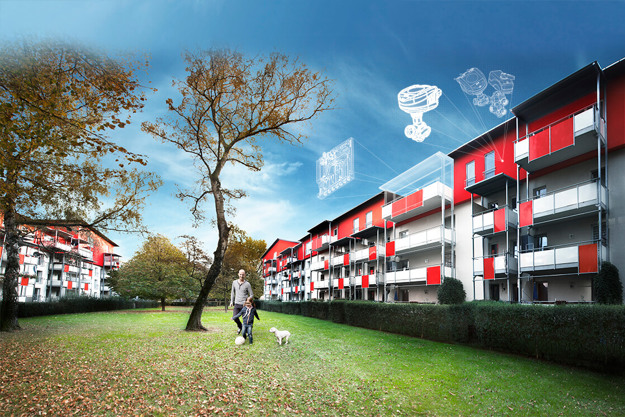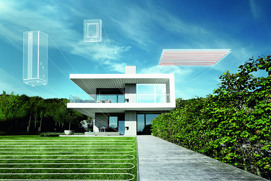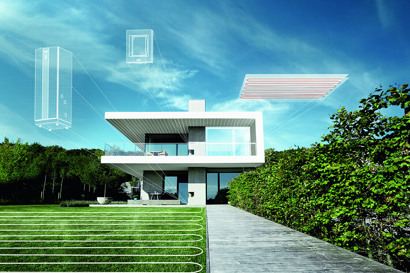Heating mats
The heating mats are used for installation in a thin layer of tile adhesive, self-leveling mixture, or similar. The standard minimum thickness of the floor layer is 5-8 mm while the thickness of electric heating mat is 3–4.5 mm. This minimizes the floor level increase. Electric heating mats consist of a thin cable securely fixed on self-adhesive glass-fiber mesh, usually of 50 cm width. Thin heating mats are manufactured as ready-made heating sections with a specific area (i.e. 0.5, 1, 1.5 … 12 m²) including a power supply cable (cold lead) and hermetically sealed connections.
Check our application manuals via the links below to get the best recommendations for design and installation of floor heating systems.
DEVI indoor application manual
Danfoss indoor application manual

Benefits of electric underfloor heating
A comfortable ambient temperature and quick response time are just a couple of the benefits electric heating offers. Learn more about these and other benefits of electric heating.
Features and benefits using heating mats
Easy and quick installation
Quick responding floor heating
Low floor height increase
High durability, no maintenance
Long life-time with up to 20-year full warranty
Product range
-
if (isSmallPicture) {


 ECdry
ECdryEcdry is all-in-one heating element, consisting of a foam construction and underlay system can be used under wooden floorings, parquets, and laminates up to 22 mm.
-
if (isSmallPicture) {


 DEVIdry™
DEVIdry™DEVIdry™ is a floor heating system consisting of a foam construction only 8 mm high with heating elements inside.
-
if (isSmallPicture) {


 ECheat
ECheatThe round profile of ECheat, very low height (only 2.5 mm) and robust construction ensure a fast, simple and safe installation, perfect for renovating existing floors.
-
if (isSmallPicture) {


 DEVImat™
DEVImat™DEVImat™ is an extremely high-quality, 360°, fully screened, twin conductor, self-adhesive, all-in-one mat with FEP insulated conductors and a red PVDF outer sheath (non UV stable).
-
if (isSmallPicture) {


 DEVIheat™ Mirror 150S
DEVIheat™ Mirror 150SDEVIheat™ Mirror 150S heating mat is used for keeping the bathroom mirror mist free by mounting the heating mat in the adhesive behind the mirror.
Related products
-
if (isSmallPicture) {


 Heating Cables
Heating CablesHeating cables are used for a variety of applications, including indoor comfort floor heating and total heating both for small houses as well as large commercial buildings.
Heating cables are mostly used in connection with new building or larger renovation projects. -
if (isSmallPicture) {


 Digital Thermostats
Digital ThermostatsDigital controllers have the unique features allowing you to reduce energy waste. Some thermostats are fitted with Wi-Fi allowing remote control of heating systems via mobile application.
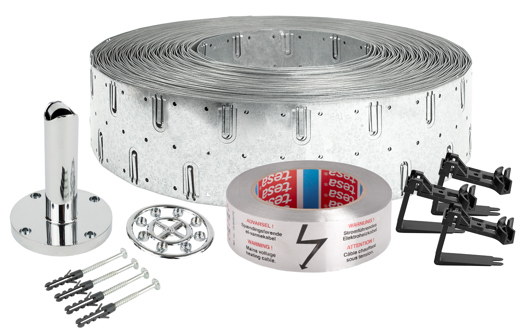
Elements of electric heating mat
- Heating cable
- Adhesive mesh
- Connection to power supply
- Connecting muff
- Supply cable
Videos
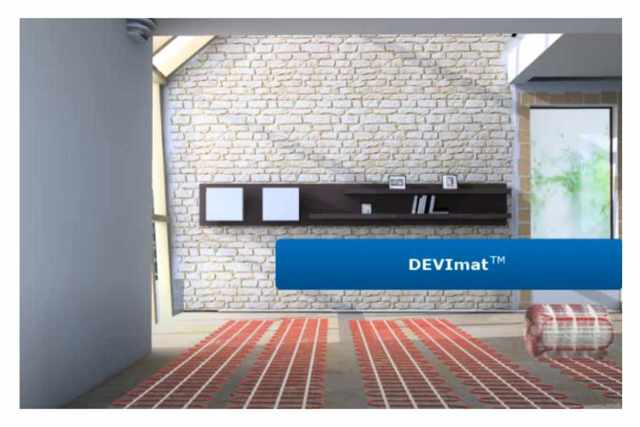
In some home renovation cases, when floor construction needs to stay as thin as possible, electric heating mats are the perfect fit. With electric heating mates floor height can be within 12-15 mm, including the tiles.
As the mats are self-adhesive, they ensure a quick and easy installation, also possible directly on the existing floor.
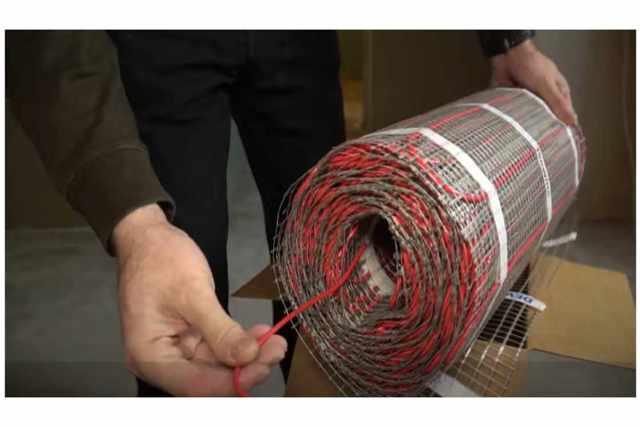
Find out how to install electric underfloor heating mat and learn how to:
- install an electric heating mat under the tiles,
- calculate the heated floor area,
- find a correct place for the sensor’s location,
- install the temperature sensor inside the conduit pipe,
- check the heating mat.
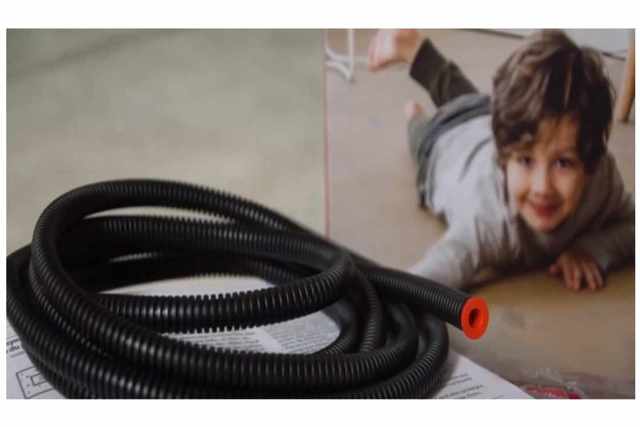
Check installation of thin heating mat for electric underfloor heating.

Electric heating videos on YouTube
You can see all our videos about Electric Heating on a dedicated playlist on YouTube. Follow the link below.
Documents
| Type | Name | Language | Valid for | Updated | Download | File type |
|---|---|---|---|---|---|---|
| Application guide | Danfoss Indoor Cable Floor Heating Systems Application manual | English | Multiple | 20 Aug, 2018 | 3.6 MB | |
| Catalog | Danfoss Product catalogue | English | Multiple | 20.8 MB | ||
| Application guide | DEVI Indoor Application manual | English | Multiple | 04 Nov, 2016 | 23.6 MB | |
| Catalog | DEVI Product Catalogue | English | Multiple | 09 Apr, 2025 | 29.5 MB | |
| Data sheet | DEVIbasic™ 20S - 230 V & 400 V | English | Multiple | 26 Mar, 2025 | 266.7 KB | |
| Data sheet | DEVIcomfort™ 100T | English | Multiple | 26 Mar, 2025 | 254.0 KB | |
| Data sheet | DEVIcomfort™ 10T | English | Multiple | 26 Mar, 2025 | 253.7 KB | |
| Data sheet | DEVIflex™ 10T | English | Multiple | 26 Mar, 2025 | 252.5 KB | |
| Data sheet | DEVIflex™ 18T | English | Multiple | 26 Mar, 2025 | 252.5 KB | |
| Data sheet | DEVIflex™ 6T | English | Multiple | 26 Mar, 2025 | 244.7 KB | |
| Data sheet | DEVIheat™ 150S & Mirror 150S | English | Multiple | 26 Mar, 2025 | 372.4 KB | |
| Data sheet | DEVImat™ 150T | English | Multiple | 24 Sep, 2025 | 340.6 KB | |
| Data sheet | ECflex 100T | English | Multiple | 17 Jul, 2023 | 687.0 KB | |
| Data sheet | ECflex 50T | English | Multiple | 17 Jul, 2023 | 684.8 KB | |
| Data sheet | ECflex 6T | English | Multiple | 23 Jul, 2020 | 438.2 KB | |
| Data sheet | ECflex 75T | English | Multiple | 17 Jul, 2023 | 695.6 KB | |
| Data sheet | ECflex™ 10T (EFTCP) | English | Multiple | 17 Jul, 2023 | 448.8 KB | |
| Data sheet | ECflex™ 18T (EFTCP) | English | Multiple | 17 Jul, 2023 | 378.4 KB | |
| Data sheet | ECflex™ 20T (EFTCP) | English | Multiple | 17 Jul, 2023 | 387.2 KB | |
| Data sheet | ECheat 150S | English | Multiple | 17 Jul, 2023 | 373.6 KB | |
| Data sheet | ECmat 100T | English | Multiple | 17 Jul, 2023 | 394.5 KB | |
| Data sheet | ECmat 150T | English | Multiple | 17 Jul, 2023 | 403.7 KB | |
| Data sheet | ECmat 200T | English | Multiple | 17 Jul, 2023 | 395.9 KB | |
| Operating guide | Outdoor Heating Applications | English | Multiple | 16 May, 2024 | 8.9 MB | |
| Operating guide | Outdoor Heating Applications | English | Multiple | 10 May, 2024 | 9.9 MB |
Tools and apps
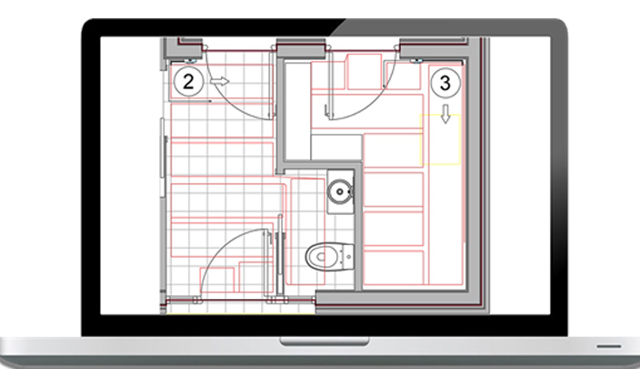
The Plugin supports your engineering and design journey by making your work faster due to simple functionalities in calculating all lengths, dimensions and product data of cables and mats. It covers all applications within Electric Heating projects: Electric floor heating, Ice & Snow melting systems, Pipe tracing, Cold stores, Sport fields, Vineyards etc.
By utilizing Plugin, you will reduce design time for the project, provide all necessary information for installers in HTML/PDF format: BoM, resistance value check list, warranty list format. It means all project information can be consolidated in one file.
Plugin can be used with AutoCAD 2017-2023.
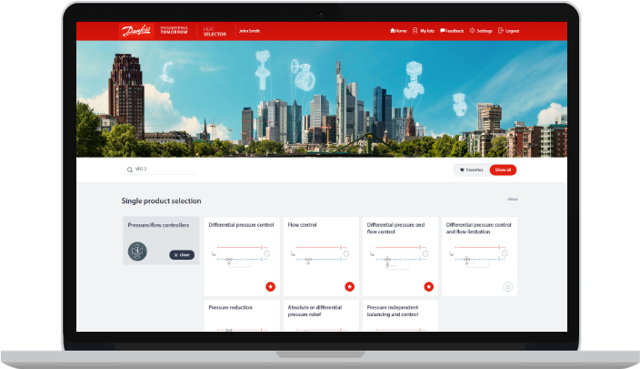
the Danfoss Heat Selector is a best-in-class online selection tool that optimizes planning process for heating application experts. The Heat Selector saves time in calculation for product selection and guides you to the recommended product mix for the application at hand. At the same time, the Heat Selector provides you with easy access to all required documentation.

FAQ
What floor finish is suitable for use with a heating mat system?
Most floor finishes are suitable for use with underfloor heating, provided the floor has been prepared correctly and any manufacturer’s temperature guidelines have been followed. With finishes, such as wood laminates and carpets, it is essential that the heating mat is completely covered with a suitable floor leveling compound before the specified finish is applied.
Moreover, for flooring, such as laminate, wooden parquet or carpet, we recommend DEVIdry™ / ECdry solutions as well as the use of a thermostat/regulator with a floor sensor.
Do we require insulation with the heating mat products?
The heating mat is designed to be laid directly onto an existing floor surface, so it does not require insulation. However, if there is room within the floor to add insulation or a tile-backer board, we strongly recommend this as it will enhance performance and reduce operating costs. Please contact us in Electric heating for information.
The fuse keeps blowing when I use the mat. What should I do?
CONTACT YOUR ELECTRICIAN. Fuses can blow or circuit breakers can trip on either short circuit or overload, short circuit being the most common cause
The heating mat is too big for the room. Can I cut it?
No, the electric heating mat cannot be shortened as this will alter the resistance of the element, which may lead to overheating. It is therefore important that the area to be heated is measured accurately (free floor area only) and that you select the closest smaller area element. Please feel to ask DEVI service for help. Mesh can be cut, but take care to not cut or damage a cable.
Does the floor need to be primed before laying the heating mat?
The mat has an adhesive backing; if the floor is dusty or greasy, it will not stick particularly well. Priming the floor will significantly help the mat to fully adhere to the floor surface.
I have a large area that requires two mats. How do I connect them together?
The cold tails/leads have to be brought out of the floor and have to be connected in parallel, e.g., core colors connected together, brown with brown, blue with blue, etc. into a thermostat.
I want to use a heating mat underneath a laminate flooring, what type of underlay do you recommend?
The underlay that is usually supplied with wood laminate is an acoustic about 2-3mm thick; this is acceptable. If you are installing anything else, please call our technical team for advice.
For laminate, we recommend DEVIdry™ / ECdry solution.
Can I put the heating mat underneath a bath or shower tray or kitchen units?
We in electric heating do not recommend that the heating mat is installed under any such fixtures for a number of reasons. For example, it can inhibit the heat being produced from the system; and, if ever a fault was to occur, it would be extremely difficult to carry out a repair.
I have a floor which is made up of both timber and concrete. Can I use a single heating mat for the floor?
We strongly recommend that each section of floor with a different covering has its own ‘mat’ as well as thermostat since each floor surface has a different maximum temperature limit. We advise to use a thermostat with a floor heating sensor.
Contact our local office to discuss the best options for this floor.
What is the width of the mat?
The actual width of the mat is 480 mm, but it is recommended that it be laid at 500 mm intervals to ensure the correct gap between runs is achieved.
What is the difference between twin & single conductor mats?
The difference between the two mats is the cold tail/lead (connection to thermostat).
The twin conductor mat does not have a second connection tail/cable to return to the thermostat. The single conductor mat has a single “cold tail” at each end of the mat, and they have to be brought back together at the connection point.
What is the black thing at the far end of the twin conductor mat?
This is the connection at the end of the twin conductor mat where the heating element is connected to the neutral return. This is manufactured within the cable.
Warranty
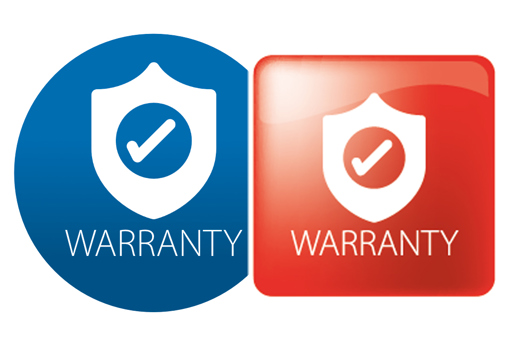
At Danfoss, it is important for us to deliver high-quality products with long-lasting effects. Should you, against all expectations, experience a problem with your product, Danfoss offers a warranty for electric heating products valid from the date of purchase that was no later than 2 years from production date.
Depending on the product, the product guarantee is valid for two years, five years, or twenty years.
Product warranty covers costs for:
- product replacement with a new comparable product or repair of the product
- transportation costs

How to register for an electric heating warranty
Learn how to properly check cables or mats, do a resistance test and take all the necessary steps to get a warranty.
Learning

Visit our Learning Center
Danfoss offers online training materials for technicians and designers working with electric heating. There are 3 e-lessons available free and on-demand through Danfoss Learning portal. For more information, register in our support section by following the link or find the overview of available relevant trainings in the table below.

DOs and DON’Ts for Indoor Electric Heating
Electric Heating is an energy-efficient and environmentally friendly floor heating solution. You can use it for either newly constructed or renovated homes.
Case stories
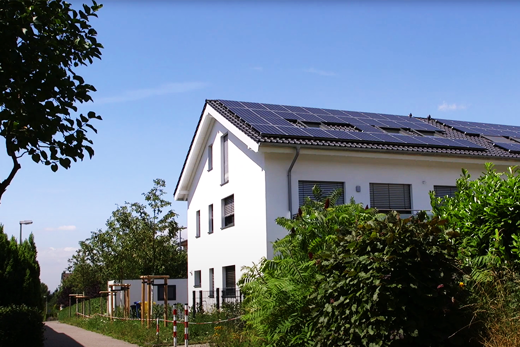
Energy-efficient heating solution for near-zero energy housing complex
For decades, many have considered electricity to be an inefficient heating source, associating it with high energy bills and pollution. However, times are changing. Now, the combination of electric floor heating and solar panels are an energy-efficient option for homeowners. Yes, the future is indeed electric, as this case from Koblenz, Germany shows.
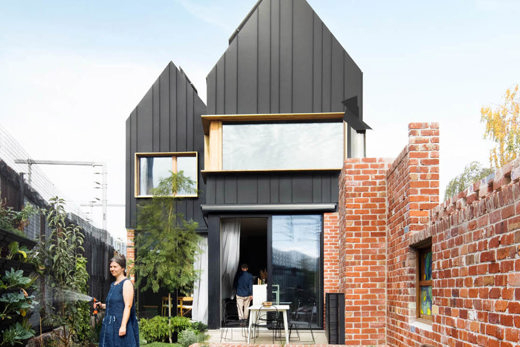
Coburg’s First Passive House, Victoria Australia
Home By Hutt, Melbourne Design Studios, and Grand Designs Australia designed and built the first Passive Home in the humble suburb of Coburg, Melbourne.
Related applications
-
if (isSmallPicture) {


 Electric floor heating
Electric floor heatingElectric underfloor heating for all types of floors
Electric heating is an energy-efficient and environmentally friendly floor heating solution. It is flexible for new build homes and renovations for both wet and dry installation.
Related solutions
-
if (isSmallPicture) {


 Commercial Buildings Retrofitting
Commercial Buildings RetrofittingEnergy retrofit of commercial buildings is a key aspect of a successful decarbonization strategy. To meet our climate targets, we must renovate existing building stock and make it more energy efficient.
-
if (isSmallPicture) {


 Energy Performance of Buildings Directive (EPBD): Everything you need to know
Energy Performance of Buildings Directive (EPBD): Everything you need to knowThe Energy Performance of Buildings Directive (EPBD) is a key legislative framework to enhance the energy efficiency in buildings. Learn about requirements, benefits and solutions.
-
if (isSmallPicture) {


 Hotels
HotelsThe hotel industry is a highly competitive sector where margins are constantly under pressure. The service towards guests must remain on a high level to hold the hotels' reputation. Saving energy is a key-differentiator. Danfoss offers comfort increasing HVAC solutions which help reduce the energy consumption.
-
if (isSmallPicture) {


 Multi-family buildings
Multi-family buildingsModern heating technology gives property owners and managers numerous ways to improve energy efficiency in their buildings. Whether planning a new build, renovation or refurbishment.
-
if (isSmallPicture) {


 Offices
OfficesThe ways office buildings are used is changing fast. Trends such as smart offices, digitalization and flexible work stations require adaptations in the technical aspects as well. Optimal indoor comfort for workers is essential. Danfoss offers comfort-increasing and energy-saving HVAC solutions.
-
if (isSmallPicture) {


 Single family houses
Single family housesHeating accounts for most of the energy used in 1- and 2-family houses. Most existing houses have the potential to realize significant energy savings, by improving the heating system and optimizing control of heating operations.
Contact us

Want to stay up-to-date?
Stay up-to-date with latest news from electric heating.
You will receive important updates, training opportunities, helpful tips and tricks and much more to make your daily work easier. Join us with one click below!
For further information, please contact us for technical support

